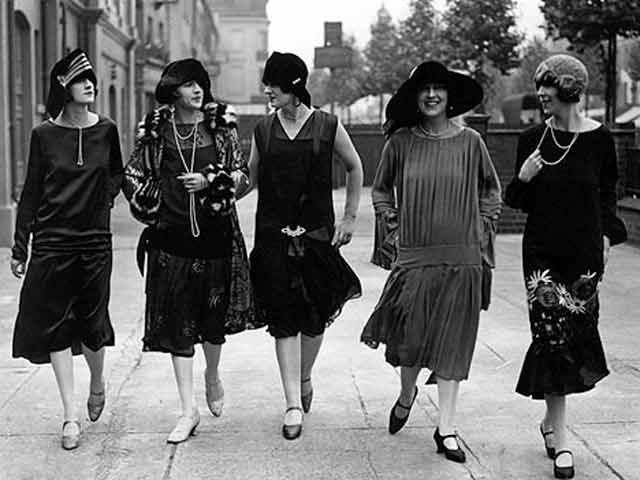With the end of the First World War, the world was gripped by euphoria. Since fashion is a reflection of what is happening around us, and so fashion responded to changes of this new found freedom. Dresses dropped their waist to the hip level and they ceased to follow the line of the body. The new trend was aiming toward simplicity, waistcoats were simple, shaped by using only a few creases on the shoulders or side seams. At the start of the new decade, skirt edges appeared above the ankle, and in just three years, the length of the skirt climbed to hitherto unseen heights.
Cuts around the neck were mostly simple round or “V.” The sleeves were long and straight or bell-shaped. On some dresses a strap on the hips appeared, and dresses in this case were falling in a straight line. Chiffon predominated among the fabrics, light silk, soft velvet, lighter wool and soft cotton. Dresses were cut simply, and the details were prevalent on the surface such as embroidery, soft braids and beads for the evening or manipulation of fabrics like pleated sewing on a machine or starching. Transparent and semi – transparent dresses with associated trunks were particularly popular on the dance floor.
The period around the year 1920 is also called the “era of flattery” (“flapper era” – on this subject I have yet to write). By 1926 the dress edge had continued their scandalous rise and had reached the knee level. The low waist still enjoyed its popularity, but skirts and waistcoats had become increasingly complex due to the seams, circular ruffles and flowing materials. Decorative scarves began to appear, contrasting fabrics and layers. Manual stringing of beads, which required a lot of time and money, was extremely popular, especially for dance dresses.


Skirt levels, which were sometimes considered indecent, were domesticated fashion collections from 1928/1929, while the asymmetric edges (dress lengths on the front side to the knee, and more on the back) announced with their appearance longer edges in the period of the 1930s. Waist was gradually raised to a level that the nature had intended for it.
The designers of the 1920s were: Patou, Molyneux, Chanel, Boue Souers, Louiseboulanger, Augustabernard and Vionnet.

During the 1920s, Zagreb also responded to the global trends, and was a free woman’s city. The women of Zagreb of that time faithfully followed European trends in fashion and lifestyle, and embraced the women’s emancipation.
In the “crazy 20s,” as this era was often called (era of the art deco), women shortened their skirts, cut their hair and began to smoke, often even pipes, wore bubikopf hair, and with the cutting of their hair they rejected the old worldview, and became promoters of the new spirit of the times. New fashion salons flourished as well.
Many ladies gave up on the elegant, expensive clothes and began wearing straight short dresses without the waist, they cut off their hair and covered themselves with the men’s jackets. The new, bold woman was born, both in appearance and behavior. The phenomenon of “garçonne” announced the mobility, speed and functionality of the new lifestyle, and it also represented the woman as the main consumer of the new era. Women accepted the tuxedo and men’s pajamas with baggy pants as well, made of silk, which were worn on the beach and at home, and the brave ones even on the street. Smoking as the new fashion sensation was featured in the magazine World in 1926. In the 1920s, the general hollywoodization and fascination with the female beauty began, which resulted in the popularization of beauty pageants.


